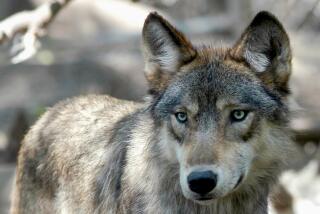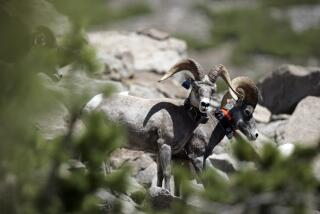Cow-size, lumpy reptile roamed ancient desert. Looked like this:
Large and lumpy with a face that looks like it’s melting, the Bunostegos was a giant reptile that roamed Earth more than 250 million years ago.
The size of a cow, the Bunostegos thrived in the Permian era, when most of the land on the planet was fused into the the supercontinent Pangea. It is one of the largest of the pareiasaurs - -an extinct, plant-eating reptile whose fossils have been found in Europe, Asia and Africa.
Fifty million years before the reign of the dinosaurs, the Bunostegos likely snacked on ferns and conifers, and shared the land with giant salamander-like amphibians and smaller reptiles, said Linda Tsuji of the University of Washington in Seattle, lead author of a paper describing the Bunostegos recently published in the Journal of Vertebrate Paleontology.
PHOTOS: Meet the top 10 newly identified species of 2012
The bulbous lumps on the Bunostegos’ head in the artist’s rendering above are not giant warts, but rather bony knobs on the animal’s skull that were likely covered in scaly, reptilian skin, Tsuji said.
“Each species of pareiasaur has bumps in the same place, but the shape and degree of the bumps is different,” she said. Tsuji said she thinks the bumps helped pareiasaurs of the same species recognize each other.
While many animals that lived on Pangea were broadly dispersed, Tsuji and her colleagues found evidence that suggests the Bunostegos was part of a group of animals that became isolated in a vast central desert in the middle of the supercontinent.
In the paper, the scientists show how the Bunostegos is more closely related to older, more primitive pareiasaurs than to the ones that were living on other parts of Pangea at the same time it was -- suggesting that Bunostegos’ genealogical lineage was isolated for millions of years.
Bunostegos fossils have been discovered near the equator in what is now Niger in Africa. When these large reptiles were alive, the climate there was super dry; heavy rains occurred in just one season of the year. Those annual rains were enough to support the plant life that a large herbivore like the Bunostegos would need to survive, Tsuji said, but the surrounding areas were likely uninhabitable, and so these large lumpy animals were stuck in a climate corral.
There is still much scientists don’t know about the Bunostegos. While the fossils have been found close together, Tsuji said she can’t say whether they lived in herds or their fossils simply got washed up together. She also isn’t sure how large their patch of habitable desert was.
Along with most of the animals from the Permian era, these bizarre looking reptiles were a victim of one of the largest mass extinctions in the planet’s history, about 248 million years ago. Scientists are still unsure what caused the extinction event -- possibly volcanic activity, rising sea levels or a general warming of the planet.
Also:
Warming oceans could kill ‘Hoff,’ the David Hasselhoff crab
Lizard named for Jim Morrison; Hunter S. Thompson also considered







